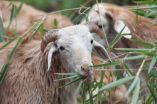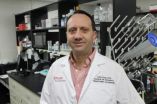(Press-News.org) Livestock production is responsible for 12% of human-related greenhouse gas emissions, primarily coming from land use change and deforestation caused by expansion of agriculture, as well as methane released by the animals themselves, with a lesser amount coming from manure management and feed production.
“There is a lot of discussion about reduction of meat in the diets as a way to reduce emissions,” says IIASA researcher Petr Havlík, who led the study “But our results show that targeting the production side of agriculture is a much more efficient way to reduce greenhouse gas emissions.”
A new study published in the journal Proceedings of the National Academy of Sciences shows that within the current systems, farmers would find it more profitable in coming years to expand livestock production in mixed systems—where livestock are fed on both grass as well as higher quality feed—rather than in pure grass-based systems. This development, would lead to a 23% reduction of emissions from land use change in the next two decades without any explicit climate mitigation policy.
Cows, sheep, and goats grow more quickly and produce more milk when they eat energy-rich diets that include grain supplements or improved forages. This means that more livestock can be raised on less land, and with fewer emissions per pound of meat or milk produced.
The new study projects that the increasing cost of land and continued yield increases in the crop sector will lead to shifts to richer animal diets in the future. Such diets are efficient not only from the perspective of greenhouse gas reduction, but also from farm profit maximization and food production.
At a moderate price of US$10 per ton of carbon dioxide equivalent, livestock system transitions within a given region, together with international relocation of production to regions with the most efficient livestock systems could also reduce the total emissions from agriculture and land use change by 25%. Most of the savings would come from avoided land use change.
Havlík says, “From the livestock sector perspective, limiting land use change seems the cheapest option both in terms of the economic cost and in terms of impact on food availability.”
Previous work by the group produced a detailed database highlighting the differences in the efficiency and greenhouse gas emissions of different livestock production systems. The new study adds to this by examining the economic potential for a transition to more efficient systems as a mitigation measure, and which policies would be the most effective for cutting greenhouse gas emissions, while also maintaining food availability.
The new study also introduces a new metric for measuring the costs of climate measures for agricultural systems, the Total Abatement Calorie Cost (TACC), which complements the pure economic metric known as “marginal abatement cost” while also capturing the impacts of mitigation measures on food security. Mario Herrero, a co-author of the study and a researcher at CSIRO, IIASA’s Australian National Member Organization, says, “Applying current metrics could lead to mitigation, but also food insecurity in developing countries, because it ignores the social cost of policies that focus just on greenhouse gas abatement.. So we developed a new metric which tells you how consumption would be affected as a result of mitigating greenhouse gas emissions.”
Changing livestock production systems remains a challenge. The researchers say that policies to provide education and market access are the keys for enabling change. In addition, they note that safeguards are needed to insure that the intensified agricultural production does not lead to environmental damage or reduce animal well-being.
INFORMATION:
Reference
Havlík P, Valin H, Herrero M, Obersteiner M, Schmid E, Rufino MC, Mosnier A, Thornton P, Boettcher, H, Conant RT, Frank S, Fritz S, Fuss S, Kraxner, F, Notenbaert, A. (2014). Climate change mitigation through livestock system transitions. Proceedings of the National Academy of Sciences http://www.pnas.org/cgi/doi/10.1073/pnas.1308044111
For more information please contact:
Petr Havlík
Research Scholar
Ecosystems Services and Management
+43(0) 2236 807 511
havlikpt@iiasa.ac.at
Katherine Leitzell
IIASA Press Office
Tel: +43 2236 807 316
Mob: +43 676 83 807 316
leitzell@iiasa.ac.at
About IIASA:
IIASA is an international scientific institute that conducts research into the critical issues of global environmental, economic, technological, and social change that we face in the twenty-first century. Our findings provide valuable options to policy makers to shape the future of our changing world. IIASA is independent and funded by scientific institutions in Africa, the Americas, Asia, Oceania, and Europe. http://www.iiasa.ac.at
Better livestock diets to combat climate change and improve food security
2014-02-24
ELSE PRESS RELEASES FROM THIS DATE:
Marine algae can sense the rainbow
2014-02-24
A new study published in Proceedings of the National Academy of Sciences has shown for the first time that several types of aquatic algae can detect orange, green and blue light.
Land plants have receptors to detect light on the red and far red of the spectrum, which are the common wavelengths in the air. These plants sense the light to move and grow as their environment changes, for example when another plant shades them from the sun. But in the ocean, the water absorbs red wavelengths, instead reflecting colours such as blue and green. As part of the study, a team of ...
A paper diagnostic for cancer
2014-02-24
CAMBRIDGE, MA -- Cancer rates in developing nations have climbed sharply in recent years, and now account for 70 percent of cancer mortality worldwide. Early detection has been proven to improve outcomes, but screening approaches such as mammograms and colonoscopy, used in the developed world, are too costly to be implemented in settings with little medical infrastructure.
To address this gap, MIT engineers have developed a simple, cheap, paper test that could improve diagnosis rates and help people get treated earlier. The diagnostic, which works much like a pregnancy ...
Species conservation poised to benefit from DNA advances
2014-02-24
A biologist at the University of York is part of an international team which has shown that advanced DNA sequencing technologies can be used to accurately measure the levels of inbreeding in wild animal populations.
The research by senior author Dr Kanchon Dasmahapatra, of the Department of Biology at York, and led by Dr Joseph Hoffman, of the Department of Animal Behaviour, Bielefeld University, Germany, may help efforts to conserve rare species.
Laboratory studies show that inbreeding reduces fitness. However, studying the impact of inbreeding in wild populations has ...
Acupuncture holds promise for treating inflammatory disease
2014-02-24
When acupuncture first became popular in the western hemisphere it had its doubters. It still does. But over time, through detailed observation, scientists have produced real evidence that ancient Chinese practitioners of the medical arts were onto something.
Now new research documents a direct connection between the use of acupuncture and physical processes that could alleviate sepsis, a condition that often develops in hospital intensive care units, springs from infection and inflammation, and takes an estimated 250,000 lives in the United States every year.
"Sepsis ...
New study shows a genetic link between feeding behavior and animal dispersal
2014-02-24
New research from the University of Toronto Scarborough shows that animal dispersal is influenced by a gene associated with feeding and food search behaviours.
The study, which was carried out by UTSC Professor Mark Fitzpatrick and PhD student Allan Edelsparre, provides one of the first aimed at gaining a functional understanding of how genes can influence dispersal tendencies in nature.
Using common fruit flies (Drosophila melanogaster), the researchers observed how two different foraging types – known as sitter flies and rover flies – moved over large distances ...
Ecotourism reduces poverty near protected parks, Georgia State University research shows
2014-02-24
ATLANTA--Protected natural areas in Costa Rica reduced poverty by 16 percent in neighboring communities, mainly by encouraging ecotourism, according to new research published today in the Proceedings of the National Academy of Sciences.
Although earlier studies indicated that establishing protected areas in poor regions can lead to reductions in poverty, there was no clear understanding why or how it happens.
"Our goal was to show exactly how environmental protection can reduce poverty in poorer nations rather than exacerbate it, as many people fear," says co-author ...
AGU: Uncovering the secret world of the Plastisphere
2014-02-24
HONOLULU – Scientists are revealing how microbes living on floating pieces of plastic marine debris affect the ocean ecosystem, and the potential harm they pose to invertebrates, humans and other animals. New research being presented here today delves deeper into the largely unexplored world of the "Plastisphere" – an ecological community of microbial organisms living on ocean plastic that was first discovered last year.
When scientists initially studied the Plastisphere, they found that at least 1,000 different types of microbes thrive on these tiny plastic islands, ...
Pinwheel 'living' crystals and the origin of life
2014-02-24
ANN ARBOR—Simply making nanoparticles spin coaxes them to arrange themselves into what University of Michigan researchers call 'living rotating crystals' that could serve as a nanopump. They may also, incidentally, shed light on the origin of life itself.
The researchers refer to the crystals as 'living' because they, in a sense, take on a life of their own from very simple rules.
Sharon Glotzer, the Stuart W. Churchill Collegiate Professor of Chemical Engineering, and her team found that when they spun individual nanoparticles in a simulation—some clockwise and some ...
New study supports body shape index as predictor of mortality
2014-02-24
In 2012, Dr. Nir Krakauer, an assistant professor of civil engineering in CCNY's Grove School of Engineering, and his father, Dr. Jesse Krakauer, MD, developed a new method to quantify the risk specifically associated with abdominal obesity.
A follow-up study, published February 20 by the online journal PLOS ONE, supports their contention that the technique, known as A Body Shape Index (ABSI), is a more effective predictor of mortality than Body Mass Index (BMI), the most common measure used to define obesity.
The team analyzed data for 7,011 adults, 18+, who participated ...
Volcanoes, including Mount Hood in the US, can quickly become active
2014-02-24
New research results suggest that magma sitting 4-5 kilometers beneath the surface of Oregon's Mount Hood has been stored in near-solid conditions for thousands of years.
The time it takes to liquefy and potentially erupt, however, is surprisingly short--perhaps as little as a couple of months.
The key to an eruption, geoscientists say, is to elevate the temperature of the rock to more than 750 degrees Celsius, which can happen when hot magma from deep within the Earth's crust rises to the surface.
It was the mixing of hot liquid lava with cooler solid magma that ...



